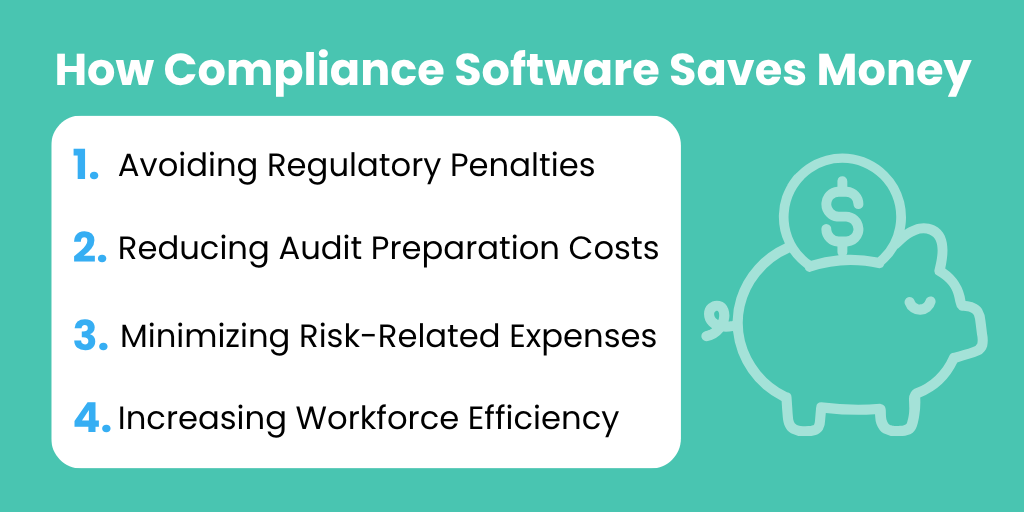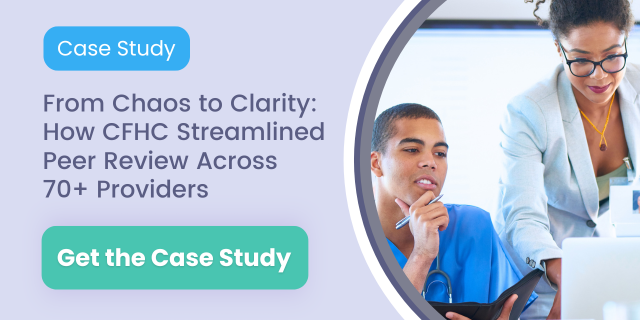4 min read
The ROI of Healthcare Compliance Software: Saving Time, Money & Stress
Performance Health Partners
October 27, 2025

Imagine cutting your audit preparation time in half, reducing the risk of costly penalties to near zero, and freeing your compliance team from hours of repetitive administrative work. That’s the promise of healthcare compliance software.
Far from being just another tool, these platforms centralize compliance activities, automate manual processes, and help organizations stay ahead of constantly changing regulations. The result is tangible savings in time and money, along with a measurable reduction in stress for both leadership and staff.
What Is Healthcare Compliance Software?
Healthcare compliance software is designed to help organizations meet and maintain regulatory requirements such as HIPAA, CMS Conditions of Participation, and state-specific healthcare rules.
Instead of relying on spreadsheets, binders, and scattered systems, compliance software consolidates policies, procedures, training records, incident reports, and audit documentation into one secure platform. Many solutions include real-time alerts, analytics dashboards, and automated workflows to ensure deadlines are met and issues are addressed quickly.
How Compliance Software Saves Time
Time is one of the most valuable resources in healthcare, yet compliance processes can drain hours from busy teams.
A study conducted by the American Medical Association found that for every hour a physician spent with a patient, an additional two hours of their time were spent on administrative tasks. Automating and centralizing these tasks helps staff focus on patient care instead of paperwork.
Automated Workflows
Manual compliance processes—assigning training, tracking completions, scheduling audits—consume valuable hours. With compliance software, these tasks can be automated and monitored without constant human oversight.
For instance, incident reports can be automatically routed to the appropriate department for review, with follow-up actions and deadlines assigned instantly. This eliminates delays in response and ensures that every step of the resolution process is documented and completed on time.
Centralized Access to Information
When policies, safety protocols, and training modules are stored in one easily searchable location, staff can access what they need within seconds. This is especially critical during urgent situations or surprise inspections, where delays in locating documentation can create compliance risks.
Continuous Monitoring
Rather than identifying gaps only during periodic reviews, healthcare compliance software provides ongoing oversight. Dashboards can highlight overdue trainings, upcoming audits, and unresolved incidents in real time, enabling proactive action instead of reactive scrambling.
How Compliance Software Saves Money
Regulatory violations are expensive, and inefficiencies carry hidden costs.
According to the American Hospital Association, U.S. health systems and hospitals spend $38.6 billion annually to comply with the administrative aspects of regulatory compliance.
Compliance software helps organizations protect their budgets while improving operational performance.
Avoiding Regulatory Penalties
Regulatory fines can be substantial.
Under HIPAA, penalties can range from $141 to over $2.1 million per violation, depending on severity and intent.
By keeping compliance activities on track and thoroughly documented, healthcare compliance software helps organizations avoid these costly mistakes.
Reducing Audit Preparation Costs
Preparing for an audit without a centralized system often requires overtime pay, temporary hires, or external consultants. Compliance software keeps records organized and accessible year-round, eliminating the scramble to gather documentation and significantly reducing associated costs.
Minimizing Risk-Related Expenses
Noncompliance can lead to lawsuits, higher insurance premiums, and reputational harm. Each of these carries a financial impact that far exceeds the cost of implementing a robust compliance platform. A well-documented program can also strengthen an organization’s position with payers and regulators.
Increasing Workforce Efficiency
By automating routine compliance work, healthcare organizations can reallocate staff time toward patient care or revenue-generating activities. Even modest gains in efficiency, such as eliminating redundant data entry or reducing training coordination time, can have a meaningful impact on operational costs.

How Compliance Software Reduces Stress
Compliance demands can create pressure for leaders and staff alike.
In fact, one study found that 66% of physicians reported that such administrative burdens negatively affected their ability to deliver high-quality care.
Centralized systems simplify workflows, improve transparency, and make inspections far less daunting.
Confidence in Audit Readiness
Few things cause more stress for compliance teams than preparing for inspections. With healthcare compliance software, documentation is always current, and audit-ready reports can be generated in minutes. This reduces the pressure of last-minute preparation and instills confidence that all requirements are met.
Clear Communication and Accountability
When compliance tasks and deadlines are tracked within a centralized system, there is no ambiguity about responsibilities. Staff receive clear assignments and reminders, and managers can see at a glance who has completed what. This transparency reduces confusion, improves accountability, and lowers stress.
Proactive Problem-Solving
Real-time alerts allow compliance teams to identify and address issues before they escalate into costly problems.
For example, if an audit deadline is approaching or a policy acknowledgment is overdue, the system immediately flags it so corrective action can be taken. This approach not only prevents compliance gaps but also supports a culture of continuous improvement, where risks are addressed early and processes are refined before they impact operations or patient safety.
Measuring the ROI of Healthcare Compliance Software
The return on investment from healthcare compliance software can be measured in both tangible and intangible ways.
Tangible metrics include:
- Reduction in staff hours spent on compliance tasks
- Decrease in overtime or consultant costs for audits
- Number of fines or penalties avoided
- Lower insurance premiums from reduced risk
Intangible benefits include:
- Improved staff morale due to less administrative burden
- Enhanced organizational reputation for compliance excellence
- Stronger patient trust
- Strengthened risk management in healthcare
While the exact ROI will vary by organization size, scope of operations, and regulatory landscape, the key benefits are consistent: time savings, cost avoidance, operational efficiency, and risk reduction.
Choosing the Right Healthcare Compliance Software
To maximize ROI, healthcare organizations should look for platforms that offer:
- Automation of recurring tasks such as incident tracking and policy updates
- Real-time dashboards and alerts
- Integration with existing systems like EHRs and HR platforms
- Scalability for future growth or multiple locations
- Strong security features to protect sensitive data
- User-friendly design to ensure high adoption rates
Selecting a vendor with healthcare-specific expertise is also important, as generic compliance tools may not address the unique regulatory requirements in the industry.
Final Thoughts
The ROI of healthcare compliance software is clear. It saves time by automating manual tasks, saves money by avoiding fines and improving efficiency, and prevents stress by giving leadership peace of mind and ensuring audit readiness.
For healthcare organizations committed to excellence, it’s not just about avoiding the risks of noncompliance. It’s about leveraging compliance as a strategic advantage. In a field where every resource counts, investing in the right compliance technology delivers measurable returns across the board.



